Cold Atom Research in Space(BEC3 GROUP)
BEC3 group focuses on the project of building an experimental platform for cold atom experiments in Chinese space station. The whole experimental platform will be stored in a standard module (cabinet)provided by space program authority in science cabin I which will be launched in 2020.
The purpose of the project is to achieve Pico kelvin ultra-low temperature and carry some challenging experiments based on the cold atom platform. There are six basic experiments which are planned to implement from 2020 to 2024, and several frontier exploration experiments will be carried from 2025 to 2030. Now, BEC3 group are working on prototype design of experimental platform.

1. Project Programme Stage
2. Initial prototype model
3. Engineering Model Stage
4. Flight Model Stage
5. Launch and On-Orbit Stage
China will launch the space station from 2018, and the science cabin I will be launched in 2020 with cold atom platform. The science cabin I is composed by nine modules, the key module is the cold atom physics experiments. BEC3 group is in charge of preliminary design of cold atom experiment platform.
Cold atom physics experiment platform consists of a 1703mm × 952.5 mm ×567mm aviation constitute module(cabinet), which consists of four main units: Ⅰ Physical unit( Scientific chamber; 2D-MOT; Atom sources Vacuum Pumps); Ⅱ Laser unit( rubidium atom laser part; potassium atom laser part; experimental laser part); Ⅲ Electronic control unit; Ⅳ Power Unit(Laser system control power; Cabinet power; Vacuum system with magnetic system power; Management part); All four units will be stored in a standard cabinet which separate in several standard drawers.
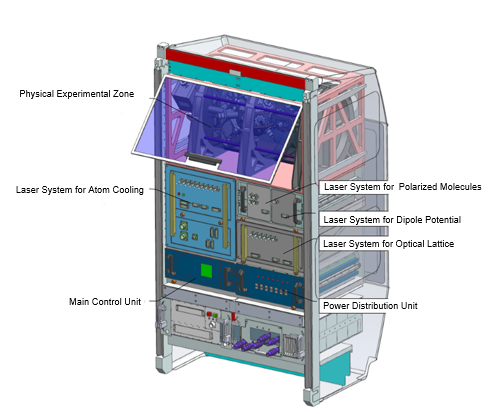
Experimental Platform for Cold Atom Experiments
1. Physical Unit
The unit is composed of four parts: 2D-MOT, Science Chamber, Vacuum Pumps and Atom Oven.
Science chamber has 26 viewports for laser injection and imaging. The vacuum level is 4*10-9Pa in the science chamber, and 2*10-8Pa in 2D-MOT which are hold by ion pumps, getter pump and titanium sublimation pump. There are 5g Rb and 5g K stored in atom oven. The K oven is home-made, which is generated by chemical reaction in the dispenser. The system placed in a SDU which volume is 413mm*953mm*585mm.
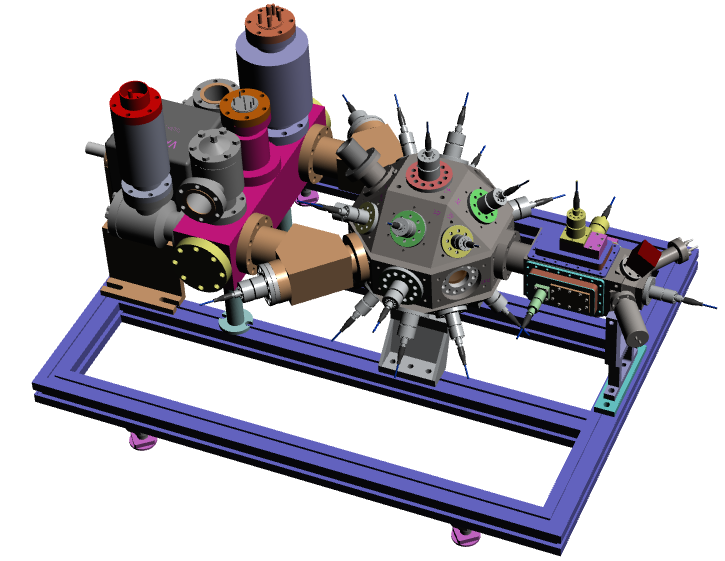
2. Laser Unit
The laser unit is distributed in different boxes.


To generate the Pico kelvin ultracold gas in microgravity, we propose a two-stage scheme to evaporatively cool atom with a multi-beam dipole trap.
To confirm the possibility of cooling of atom in microgravity to the ultracold regime beyond the earth, we apply the Direct Monte Carlo Simulation (DSMC) method for Rb cold atom and study the evaporative cooling process with gravitational force in optical dipole traps. In a microgravity environment, the evaporative cooling can be done in a two step optical trap decomposing process and the Rb atomic gas could reach quantum degeneracy regime with a temperature of few Pico kelvins.
(1)Load cold atoms: to add a crossing two narrow beams of 1064nm, each with a waist of 60 m m and power of 5W, we create a tight-confining dipole trap, Fig. 2.(a).105atoms with a temperature of 10mK were loaded into the trap, initial phase space density of less than 10^3.
(2)Ramp down the trap: the beam is ramped down to 1.5mW by equation(1)in the first 5 seconds, with parameters
while the waists of the beams are maintained. The resulting condensate has 4000 atoms, and a temperature T ~ 5nK.
(3) Change to the shallow trap: overlap the trap with a much wider and shallower crossed-beam trap, whose waist (power) is 3mm (30mW) each, Fig 2(b). Continue ramping down the power of the narrower beams, parameters of
remains, Fig 2 (c). In the end, we obtain a condensate of ~3000 atoms with temperature of ~7 pK, Fig.3.
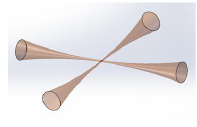
Fig 2(a) Evaporation cooling in a tight-confining crossed-beam dipole trap.

Fig 2(b) Overlapping the trap with a wider and weaker crossed-beam dipole trap.

Fig 2(c) Decompression in the combined trap for 10s.
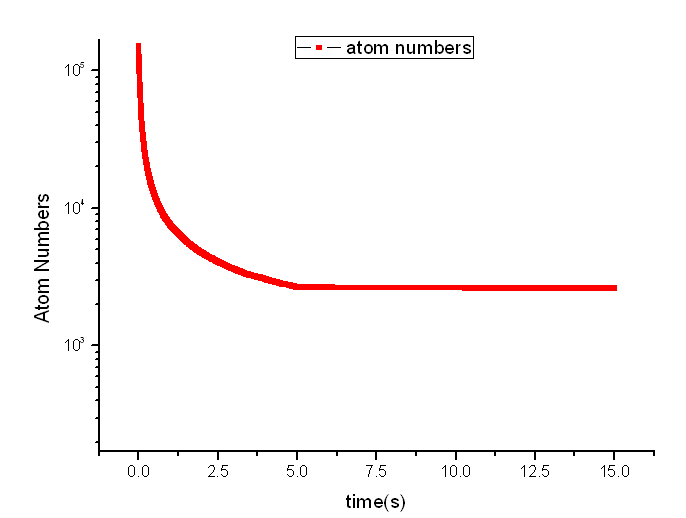
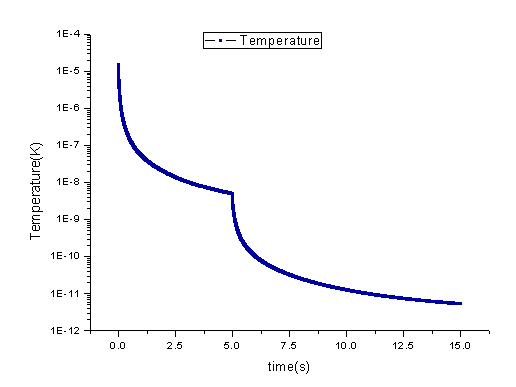
Fig 3 Evolution of Rb atomic number and temperature in microgravity, (a) Total number of atoms versus time, (b) Temperature versus time.
References
[1]Generating a picokelvin ultracold atomic ensemble in microgravity, Lu Wang, Peng Zhang, Xu-Zong Chen and Zhao-Yuan Ma,J. Phys. B: At. Mol. Opt. Phys. 46 195302 (2013)
[2]Two-stage crossed beam cooling with 6Li and 133Cs atoms in microgravity,Tian Luan, Hepeng Yao, Lu Wang, Chen Li, Shifeng Yang, Xuzong Chen, and Zhaoyuan Ma,Opt. Express23, 11378 (2015)
[3]Comparison of different techniques in optical trap for generating picokelvin 3D atom cloud in microgravity,Hepeng Yao, Tian Luan, Chen Li,Yin Zhang, Zhaoyuan Ma, Xu-Zong Chen,Optics Communications359: 123-128 (2016)